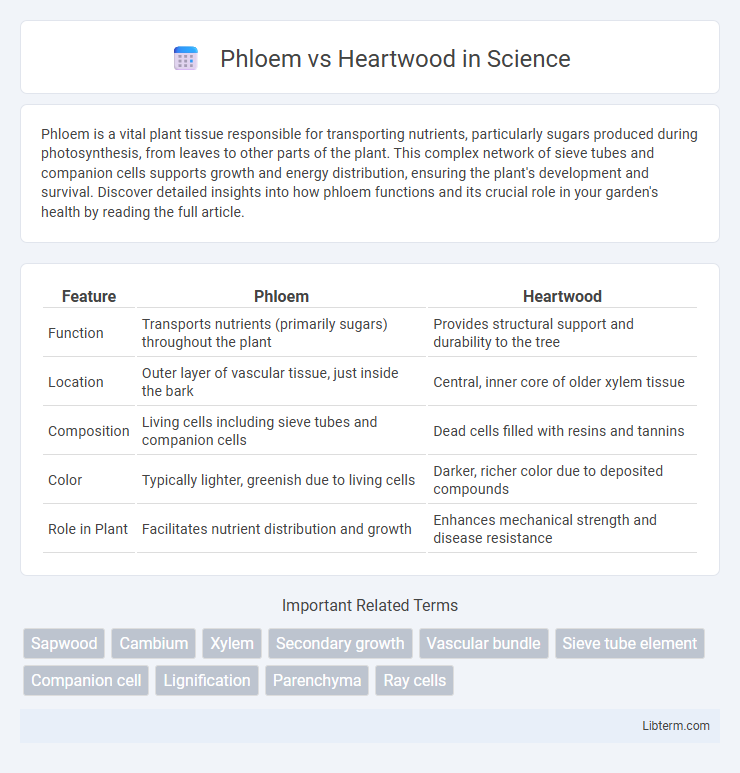Phloem is a vital plant tissue responsible for transporting nutrients, particularly sugars produced during photosynthesis, from leaves to other parts of the plant. This complex network of sieve tubes and companion cells supports growth and energy distribution, ensuring the plant's development and survival. Discover detailed insights into how phloem functions and its crucial role in your garden's health by reading the full article.
Table of Comparison
| Feature | Phloem | Heartwood |
|---|---|---|
| Function | Transports nutrients (primarily sugars) throughout the plant | Provides structural support and durability to the tree |
| Location | Outer layer of vascular tissue, just inside the bark | Central, inner core of older xylem tissue |
| Composition | Living cells including sieve tubes and companion cells | Dead cells filled with resins and tannins |
| Color | Typically lighter, greenish due to living cells | Darker, richer color due to deposited compounds |
| Role in Plant | Facilitates nutrient distribution and growth | Enhances mechanical strength and disease resistance |
Introduction to Phloem and Heartwood
Phloem is a vital vascular tissue in plants responsible for transporting organic nutrients, primarily sugars, from the leaves to other parts, facilitating growth and storage. Heartwood, the central, non-living part of a tree trunk, provides structural support and durability due to its dense, lignified cells and accumulation of chemical compounds that resist decay. Understanding the distinct functions and compositions of phloem and heartwood is essential for studying plant physiology and wood science.
Definition of Phloem
Phloem is a vascular tissue in plants responsible for transporting organic nutrients, primarily sugars produced through photosynthesis, from the leaves to other parts of the plant. Unlike heartwood, which is the dense, non-living central wood providing structural support, phloem is located in the outer layers, just beneath the bark. Phloem consists of living cells, including sieve elements and companion cells, facilitating the active movement of sap throughout the plant.
Definition of Heartwood
Heartwood is the central, non-living part of a tree trunk composed of old xylem cells that have become hardened and resistant to decay. Unlike the phloem, which transports nutrients and remains active, heartwood serves primarily as structural support and protects the tree by providing resistance against pathogens and environmental stress. Its distinct darker color results from the accumulation of resins, tannins, and other chemical substances within the cells.
Structural Differences between Phloem and Heartwood
Phloem and heartwood differ significantly in their structural composition and function within trees. Phloem consists of living cells, including sieve elements and companion cells, designed to transport nutrients like sugars from the leaves to other parts of the plant, whereas heartwood is made up of dead, densely packed xylem cells that provide structural support and resistance to decay. The phloem's thin-walled cells contrast with the heartwood's thick-walled, lignified cells that contribute to the tree's rigidity and durability.
Functions of Phloem in Plants
Phloem serves as the primary tissue responsible for transporting organic nutrients, particularly sucrose, throughout the plant from leaves to growing tissues and storage organs. It consists of sieve tube elements and companion cells that facilitate the distribution of photosynthates essential for growth, development, and storage. Unlike heartwood, which provides structural support and resistance to decay, phloem plays a vital role in nutrient translocation and overall plant metabolism.
Functions of Heartwood in Trees
Heartwood provides structural support and durability to trees by forming the central, non-living core that resists decay and insect damage. It stores metabolites and secondary compounds such as tannins and resins, which protect against pathogens and environmental stress. Unlike phloem, which transports nutrients, heartwood primarily serves as a protective and supportive tissue essential for the tree's long-term stability.
Composition of Phloem vs Heartwood
Phloem primarily consists of living cells such as sieve elements, companion cells, phloem fibers, and parenchyma, facilitating the transport of organic nutrients, especially sugars, throughout the plant. In contrast, heartwood is composed mainly of dead cells impregnated with resins, tannins, and other extractives that provide structural support and resistance to decay. The chemical composition of heartwood includes complex polymers like lignin and phenolic compounds, which differ significantly from the primarily cellulose and living cellular content of phloem.
Location and Appearance
Phloem is located in the outer layers of a tree just beneath the bark, characterized by its soft, often greenish or light brown appearance due to living cells involved in nutrient transport. Heartwood is found in the central core of the tree trunk, distinguished by its darker, denser, and more rigid structure resulting from the accumulation of dead cells and deposits like tannins and resins. The contrasting positions reflect their functions: phloem facilitates food conduction from leaves to roots, while heartwood provides structural support and resistance to decay.
Importance in Plant Growth and Survival
Phloem plays a critical role in plant growth and survival by transporting essential nutrients, primarily sugars produced through photosynthesis, from the leaves to various parts of the plant for energy and development. In contrast, heartwood, composed of dead cells, provides structural support and protection against pathogens, ensuring the plant's stability and longevity. Together, phloem facilitates nutrient distribution while heartwood reinforces durability, both crucial for maintaining a healthy and thriving plant.
Key Differences: Phloem vs Heartwood
Phloem is the living tissue in vascular plants responsible for transporting organic nutrients, primarily sugars, from leaves to other parts of the plant. Heartwood is the non-living, central wood of a tree, providing structural support and resistance to decay, composed of old xylem cells that have ceased water conduction. While phloem is involved in nutrient distribution and remains active, heartwood serves a mechanical function and is typically darker due to deposited substances like tannins and resins.
Phloem Infographic

 libterm.com
libterm.com